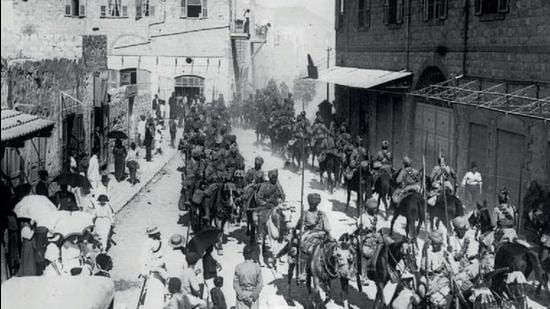How Mysore cavalrymen led the charge in battle of Haifa
The Teen Murti narrates the story of India’s triumph in the Battle of Haifa, which was then a part of the Ottoman Empire, on September 23, 1918, during World War 1. The three statues depict the cavalries of three Indian princely states, Jodhpur, Hyderabad and Mysore (now Mysuru).
For the average Indian, the Teen Murti Bhavan in New Delhi is the former residence of India’s first prime minister Pandit Jawaharlal Nehru. The building, however, derives its name from the Teen Murti (three statues) memorial designed by British sculptor Leonard Jennings, located at the road junction in front of the building.

The Teen Murti narrates the story of India’s triumph in the Battle of Haifa, which was then a part of the Ottoman Empire, on September 23, 1918, during World War 1. The three statues depict the cavalries of three Indian princely states, Jodhpur, Hyderabad and Mysore (now Mysuru).
The battle was fought alongside the British 15th Imperial Service Cavalry Brigade to defeat the Ottoman soldiers and liberate a strategically important port town. The battle took place around two months before the end of World War 1. During the battle, the cavalrymen from Mysore, handpicked by Maharaja of Mysore Nalwadi Krishnaraja Wadiyar, attacked the town and captured more than 1,350 soldiers.
Haifa was a strategically important location for the Allied Powers – led by France, Britain, Russia, Italy, Japan, and the United States – as it had a deep-water harbour and an airfield. Haifa became one of the main supply bases and arms depots, serving the Middle East forces during the war. A large naval depot was established at Haifa Bay. When the Ottoman Empire captured this town, they made sure it was defended heavily as it was a major resupply point. And when the allies began the Sinai and Palestine campaign, recapture of the Haifa was a priority.
According to records, the 5th Cavalry Division was assigned the task of capturing Haifa. Since the defenders of the city were well-entrenched, the initial attacks were not successful, which is when the Mysore and Jodhpur Lancers were called in to finish the job.
The Mysore Lancers were a personal force of the Mysore Maharaja. After he pledged troops for the war, the lancers were his first choice, said R Ashok Urs, who studied the force. “The king donated ₹50 lakh and 700 soldiers from his cavalry as his contribution to the war. He even wrote a letter to his men telling them that it was their chance to prove that they were the best fighting unit in the world,” said Urs.
In October 1914, the Mysore regiment left Bengaluru (then Bangalore) for the Middle East. A convoy of 36 ships carried the troops from India to the Suez Canal.
On September 23, 1918, the task in front of the cavalry seemed impossible. Situated between the Kishon River and the slopes of Mount Carmel, the city was well-defended and was supported by artillery guns. While the Jodhpur Lancers were tasked to capture these artillery positions, the Mysore Lancers were ordered to attack the town from the east and north.
The Mysore Lancers moved into position by climbing up a steep track to capture and disable the guns. The Jodhpur Lancers launched the main mounted attack on the rear-guard of the German machine gunners, which blocked the 3.2km road leading to the town. This was followed by the final push by both units.
At the end of the bloody battle, the two regiments captured 1,350 German and Ottoman prisoners, including two German officers, 35 Ottoman officers, 17 artillery guns, including four 4.2 guns, eight 77mm guns, four camel guns as well as a 6-inch naval gun, and 11 machine guns. Eight cavalrymen from the Mysore Lancers lost their lives in the battle, while 34 were wounded.
The Mysore Lancers returned home in 1920 after participating in other campaigns of the British armies. Post-independence, the Lancers units were merged with the Indian Army’s 61 cavalry. While the identity of the Mysore Lancers was lost after the merger, the Indian Army still remembers the history of the unit that did the impossible in World War I.
In 2017, during his tour of Israel, Prime Minister Narendra Modi visited Haifa and renamed the Teen Murti Chowk to Teen Murti Haifa Chowk on his return. “We remember with pride those Indian troops who, one hundred years ago in Haifa, displayed valour, courage and heroism in the face of seemingly impossible odds,” he said during his visit.
In a quiet corner on Bengaluru’s JC Nagar, another stature bears witness to the heroic acts of these brave cavalrymen from Mysore. The statue, which is otherwise a spectator to the regular traffic jams at the junction, is decked once a year when families of the soldiers come together to pay their respects. “It is a shame that brave lancers of the Mysore don’t find a mention in the history textbooks, even though they were heroes,” remarked Urs.
Get Current Updates on India News, Lok Sabha election 2024 live, Election 2024 along with Latest News and Top Headlines from India and around the world.




